Research on Cognition and Adaptation to Climate Risks among Inland Northwest Chinese Residents
Abstract
:1. Introduction
2. Data Sources and Technical Methods
2.1. Data Sources
2.2. Variable Selection
2.3. Research Methodology
3. Results and Analysis
3.1. Characterization of Facts
3.1.1. Climate Change Perception Analysis
3.1.2. Climate Risk Sensitivity Analysis
3.1.3. Climate Risk Adaptation Analysis
3.1.4. Evaluation of Adaptation Measures in the Public Sector
3.2. Analysis of Impact Mechanisms
3.2.1. Climate Change Perception
- 1.
- Climate Change Beliefs
- 2.
- Climate Change Attribution
3.2.2. Climate Risk Sensitivity
- 1.
- Climate Change Impact Cognition
- 2.
- Climate Change Affects Demand
3.2.3. Climate Risk Adaptation
3.2.4. Evaluation of Adaptation Measures in the Public Sector
4. Conclusions and Recommendations
- With the increasing urban heat island effect, residents of Xi’an are more likely to reach a higher level of belief in climate change regarding prolonged weather events. Notably, the middle-aged and elderly groups exhibit lower levels of belief in climate change, while the group with no formal education shows higher levels of belief. Residents’ perceptions of climate change correlate closely with their risk exposure levels. Individuals who spend more time outdoors due to their lifestyles or occupations tend to have higher risk exposure and stronger beliefs in climate change. To enhance resident preparedness for potential climate disasters, the government could effectively disseminate scientific meteorological knowledge and depict the consequences of climate change through realistic visualizations, thereby enhancing public climate risk perception.
- Xi’an residents lack a general consensus on the attribution of climate change, with only 40.1% attributing it primarily to human activities. The middle-aged and elderly groups are more inclined to attribute climate change to natural causes or remain oblivious to it, with those with less education showing a more ambiguous understanding. The substantial disparity between the scientific consensus on the anthropogenic origins of climate change and the high level of skepticism among citizens underscores the critical need for education as a paramount concern moving forward. Therefore, the government should prioritize climate change education for these demographics by creating and sharing short science films on user-friendly platforms like Weibo, TikTok, and Xiaohongshu.
- Xi’an residents’ attitudes toward future climate risks are overly optimistic, with 89.6% dismissing the likelihood of serious negative impacts, particularly among the elderly and postgraduates, who exhibit minimal concern and anxiety. A potential challenge arises when optimistic and highly educated individuals, who wield significant influence over policymaking, fail to proactively address climate risks in the face of incomplete information. A potential challenge arises when optimistic and highly educated individuals, who wield significant influence over policymaking, fail to proactively address climate risks in the face of incomplete information. Residents acknowledge that “summer heat” will have the most substantial impact on their daily lives and well-being. Women, individuals aged 25–54, and postgraduates demonstrate higher susceptibility to climate risks impacts, contrasting the overall subdued level of climate change concern. Leveraging big data on group activities could aid the government in identifying traffic congestion hotspots during peak hours and optimizing road management for improved traffic efficiency.
- There exists a notable uncertainty regarding residents’ adaptability to climate change risks, especially among females and younger individuals displaying more negative cognitions. The internet remains a primary source for residents to obtain weather information, with limited cognition and trust in weather insurance policies.
- Residents express the lowest satisfaction with public sector efforts related to “hazard insurance”, followed by “flood defense and drainage improvements” and “public education” initiatives. Enhancements are urgently needed in weather disaster insurance products, support systems, and operational models. Gender, tenure, age, education, and income levels exhibit varying degrees of public sector responses to climate risks.
Author Contributions
Funding
Institutional Review Board Statement
Informed Consent Statement
Data Availability Statement
Acknowledgments
Conflicts of Interest
References
- WMO State Global Climate 2021 (WMO-No.1290). Available online: https://library.wmo.int/idurl/4/56300 (accessed on 14 December 2023).
- CMA Climate Change Centre. Blue Book on Climate Change in China (2022); Science Press: Beijing, China, 2022. [Google Scholar]
- IPCC Climate Change 2022: Impacts, Adaptation and Vulnerability. Available online: https://www.ipcc.ch/report/sixth-assessment-report-working-group-ii/ (accessed on 12 December 2023).
- Fang, X.Q.; Yin, P.H. Review on the three key concepts of resilience, vulnerability and adaptation in the research of global environmental change. Prog. Geogr. 2007, 26, 11–22. [Google Scholar] [CrossRef]
- Yu, G.L.; Wang, Q.L.; Yang, Z.L. Environmental Psychology; People’s Education Press: Beijing, China, 2000. [Google Scholar]
- Smith, K. Environmental Hazards: Assessing Risk and Reducing Disaster; Routledge: London, UK; New York, NY, USA, 1996. [Google Scholar]
- Löfstedt, R.; Frewer, L. Risk & Modern Society; Earthscan Publications: London, UK, 1998. [Google Scholar]
- Yun, Y.R.; Fang, X.Q.; Tian, Q.; Zhang, X.Z. Peasants′ perception and cognition to climate change in Mohe county, Heilongjiang Province. Sci. Geogr. Sin. 2009, 29, 745–749. [Google Scholar]
- Figner, B.; Weber, E.U. Who takes risks when and why? Determinants of risk taking. Curr. Dir. Psychol. Sci. 2011, 20, 211–216. [Google Scholar] [CrossRef]
- Song, L. Climate risks recognizing and adaptation ability of Shanghai residents. Urban Probl. 2014, 2, 62–69. [Google Scholar] [CrossRef]
- Jones, N.; Clark, J.; Tripidaki, G. Social risk assessment and social capital: A significant parameter for the formation of climate change policies. Soc. Sci. J. 2012, 49, 33–41. [Google Scholar] [CrossRef]
- Peng, L.M.; Peng, Y.H. Analysis of survey on urban residents’ cognition of climate change risk in Guangzhou. Yuejiang Acad. J. 2012, 4, 40–47. [Google Scholar] [CrossRef]
- Cui, W.J.; Luo, Y. Effects of urban residents climate change risk perception on travel mode choice: Based on 620 urban residents investigation. Ecol. Econ. 2014, 30, 119–123+155. [Google Scholar]
- Xie, X.L.; Zheng, Y. Perception of climate disaster risks and adaptation of urban residents: Analysis based on the social survey of Shanghai. Urban Environ. Stud. 2014, 1, 80–91. [Google Scholar]
- Du, F.L.; Li, L.I.; Du, Y.R. Empirical study on the herders’ perception and adaptive strategies to the extreme weather risks in Inner Mongolia. J. Arid. Land Resour. Environ. 2015, 29, 132–137. [Google Scholar] [CrossRef]
- Yu, Y. Farmers’ attitudes towards low-probability climate change risks: Hurricane insurance will pay. Jiangsu Agric. Sci. 2016, 44, 153. [Google Scholar] [CrossRef]
- Brouwer, R.; Akter, S.; Brander, L.; Haque, E. Socioeconomic vulnerability and adaptation to environmental risk: A case study of climate change and flooding in Bangladesh. Risk Anal. Int. J. 2007, 27, 313–326. [Google Scholar] [CrossRef] [PubMed]
- Alam, G.M.; Alam, K.; Mushtaq, S. Climate change perceptions and local adaptation strategies of hazard-prone rural households in Bangladesh. Clim. Risk Manag. 2017, 17, 52–63. [Google Scholar] [CrossRef]
- Abid, M.; Schilling, J.; Scheffran, J.; Zulfiqar, F. Climate change vulnerability, adaptation and risk perceptions at farm level in Punjab, Pakistan. Sci. Total Environ. 2016, 547, 447–460. [Google Scholar] [CrossRef] [PubMed]
- Ali, A.; Erenstein, O. Assessing farmer use of climate change adaptation practices and impacts on food security and poverty in Pakistan. Clim. Risk Manag. 2017, 16, 183–194. [Google Scholar] [CrossRef]
- Gentle, P.; Maraseni, T.N. Climate change, poverty and livelihoods: Adaptation practices by rural mountain communities in Nepal. Environ. Sci. Policy 2012, 21, 24–34. [Google Scholar] [CrossRef]
- Dang, H.L.; Li, E.; Nuberg, I.; Bruwer, J. Understanding farmers’ adaptation intention to climate change: A structural equation modelling study in the Mekong Delta, Vietnam. Environ. Sci. Policy 2014, 41, 11–22. [Google Scholar] [CrossRef]
- Esham, M.; Garforth, C. Agricultural adaptation to climate change: Insights from a farming community in Sri Lanka. Mitig. Adapt. Strateg. Glob. Change 2013, 18, 535–549. [Google Scholar] [CrossRef]
- Arbuckle, J.G.; Prokopy, L.S.; Haigh, T.; Hobbs, J.; Knoot, T.; Knutson, C.; Loy, A.; Mase, A.S.; McGuire, J.; Morton, L.W.; et al. Climate change beliefs, concerns, and attitudes toward adaptation and mitigation among farmers in the Midwestern United States. Clim. Change 2013, 117, 943–950. [Google Scholar] [CrossRef]
- Philippenko, X.; Goeldner-Gianella, L.; Cozannet, G.L.; Grancher, D.; Torre, Y.D. Perceptions of climate change and adaptation: A subarctic archipelago perspective (Saint-Pierre-and-Miquelon, North America). Ocean. Coast. Manag. 2021, 215, 105924. [Google Scholar] [CrossRef]
- Frank, E.; Eakin, H.; López-Carr, D. Social identity, perception and motivation in adaptation to climate risk in the coffee sector of Chiapas, Mexico. Glob. Environ. Change 2011, 21, 66–76. [Google Scholar] [CrossRef]
- Soito, J.L.; Freitas, M.A.V. Amazon and the expansion of hydropower in Brazil: Vulnerability, impacts and possibilities for adaptation to global climate change. Renew. Sustain. Energy Rev. 2011, 15, 3165–3177. [Google Scholar] [CrossRef]
- Wamsler, C.; Brink, E.; Rentala, O. Climate change, adaptation, and formal education: The role of schooling for increasing societies’ adaptive capacities in El Salvador and Brazil. Ecol. Soc. 2012, 17, 2. [Google Scholar] [CrossRef]
- Lemos, M.C.; Lo, Y.J.; Nelson, D.R.; Eakin, H.; Bedran-Martins, A.M. Linking development to climate adaptation: Leveraging generic and specific capacities to reduce vulnerability to drought in NE Brazil. Glob. Environ. Change 2016, 39, 170–179. [Google Scholar] [CrossRef]
- Barros, V.R.; Boninsegna, J.A.; Camilloni, I.A.; Chidiak, M.; Magrín, G.O.; Rusticucci, M. Climate change in Argentina: Trends, projections, impacts and adaptation. Wiley Interdiscip. Rev. Clim. Change 2015, 6, 151–169. [Google Scholar] [CrossRef]
- McDowell, J.Z.; Hess, J.J. Accessing adaptation: Multiple stressors on livelihoods in the Bolivian highlands under a changing climate. Glob. Environ. Change 2012, 22, 342–352. [Google Scholar] [CrossRef]
- Bryan, E.; Deressa, T.T.; Gbetibouo, G.A.; Ringler, C. Adaptation to climate change in Ethiopia and South Africa: Options and constraints. Environ. Sci. Policy 2009, 12, 413–426. [Google Scholar] [CrossRef]
- Deressa, T.T.; Hassan, R.M.; Ringler, C.; Alemu, T.; Yesuf, M. Determinants of farmers’ choice of adaptation methods to climate change in the Nile Basin of Ethiopia. Glob. Environ. Change 2009, 19, 248–255. [Google Scholar] [CrossRef]
- Deressa, T.T.; Hassan, R.M.; Ringler, C. Perception of and adaptation to climate change by farmers in the Nile basin of Ethiopia. J. Agric. Sci. 2011, 149, 23–31. [Google Scholar] [CrossRef]
- Thomas, D.S.; Twyman, C.; Osbahr, H.; Hewitson, B. Adaptation to climate change and variability: Farmer responses to intra-seasonal precipitation trends in South Africa. Clim. Change 2007, 83, 301–322. [Google Scholar] [CrossRef]
- Paavola, J. Livelihoods, vulnerability and adaptation to climate change in Morogoro, Tanzania. Environ. Sci. Policy 2008, 11, 642–654. [Google Scholar] [CrossRef]
- Patt, A.G.; Schröter, D. Perceptions of climate risk in Mozambique: Implications for the success of adaptation strategies. Glob. Environ. Change 2008, 18, 458–467. [Google Scholar] [CrossRef]
- Fosu-Mensah, B.Y.; Vlek, P.L.G.; MacCarthy, D.S. Farmers’ perception and adaptation to climate change: A case study of Sekyedumase district in Ghana. Environ. Dev. Sustain. 2012, 14, 495–505. [Google Scholar] [CrossRef]
- Reidsma, P.; Ewert, F.; Lansink, A.O.; Leemans, R. Adaptation to climate change and climate variability in European agriculture: The importance of farm level responses. Eur. J. Agron. 2010, 32, 91–102. [Google Scholar] [CrossRef]
- Reckien, D.; Flacke, J.; Dawson, R.J.; Heidrich, O.; Olazabal, M.; Foley, A.M.; Hamann, J.J.; Orru, H.; Salvia, M.; Gregorio Hurtado, S.; et al. Climate change response in Europe: What’s the reality? Analysis of adaptation and mitigation plans from 200 urban areas in 11 countries. Clim. Change 2013, 122, 331–340. [Google Scholar] [CrossRef]
- Massey, E.; Biesbroek, R.; Huitema, D.; Jordan, A. Climate policy innovation: The adoption and diffusion of adaptation policies across Europe. Glob. Environ. Change 2014, 29, 434–443. [Google Scholar] [CrossRef]
- Persson, J.; Blennow, K.; Gonçalves, L.; Borys, A.; Dutcă, I.; Hynynen, J.; Janeczko, E.; Lyubenova, M.; Martel, S.; Merganic, J.; et al. No polarization–Expected Values of Climate Change Impacts among European Forest Professionals and Scientists. Sustainability 2020, 12, 2659. [Google Scholar] [CrossRef]
- Grafakos, S.; Viero, G.; Reckien, D.; Trigg, K.; Viguie, V.; Sudmant, A.; Graves, C.; Foley, A.; Heidrich, O.; Mirailles, J.M.; et al. Integration of mitigation and adaptation in urban climate change action plans in Europe: A systematic assessment. Renew. Sustain. Energy Rev. 2020, 121, 109623. [Google Scholar] [CrossRef]
- Wheeler, S.; Zuo, A.; Bjornlund, H. Farmers’ climate change beliefs and adaptation strategies for a water scarce future in Australia. Glob. Environ. Change 2013, 23, 537–547. [Google Scholar] [CrossRef]
- Mortreux, C.; Barnett, J. Climate change, migration and adaptation in Funafuti, Tuvalu. Glob. Environ. Change 2009, 19, 105–112. [Google Scholar] [CrossRef]
- Ding, Y.H.; Liu, Y.J.; Xu, Y.; Wu, P.; Xue, T.; Wang, J.; Shi, Y.; Zhang, Y.X.; Song, Y.F.; Wang, P.L. Regional responses to global climate change: Progress and prospects for trend, causes, and projection of climatic warming-wetting in Northwest China. Adv. Earth Sci. 2023, 38, 551–562. [Google Scholar] [CrossRef]
- Blennow, K.; Persson, J.; Gonçalves, L.M.S.; Borys, A.; Dutcă, I.; Hynynen, J.; Janeczko, E.; Lyubenova, M.; Merganič, J.; Merganičová, K.; et al. The role of beliefs, expectations and values in decision-making favoring climate change adaptation—implications for communications with European forest professionals. Environ. Res. Lett. 2020, 11, 114061. [Google Scholar] [CrossRef]
- Sun, Y.; Chen, X.F.; Gong, Y.C.; Tian, J.C.; Ji, Z.Y.; Li, Y.; Guo, H.Y.; Han, J.; Zhang, L.X. Progress and development suggestions for psychological research on climate change. Bull. Chin. Acad. Sci. 2023, 38, 1197–1211. [Google Scholar] [CrossRef]
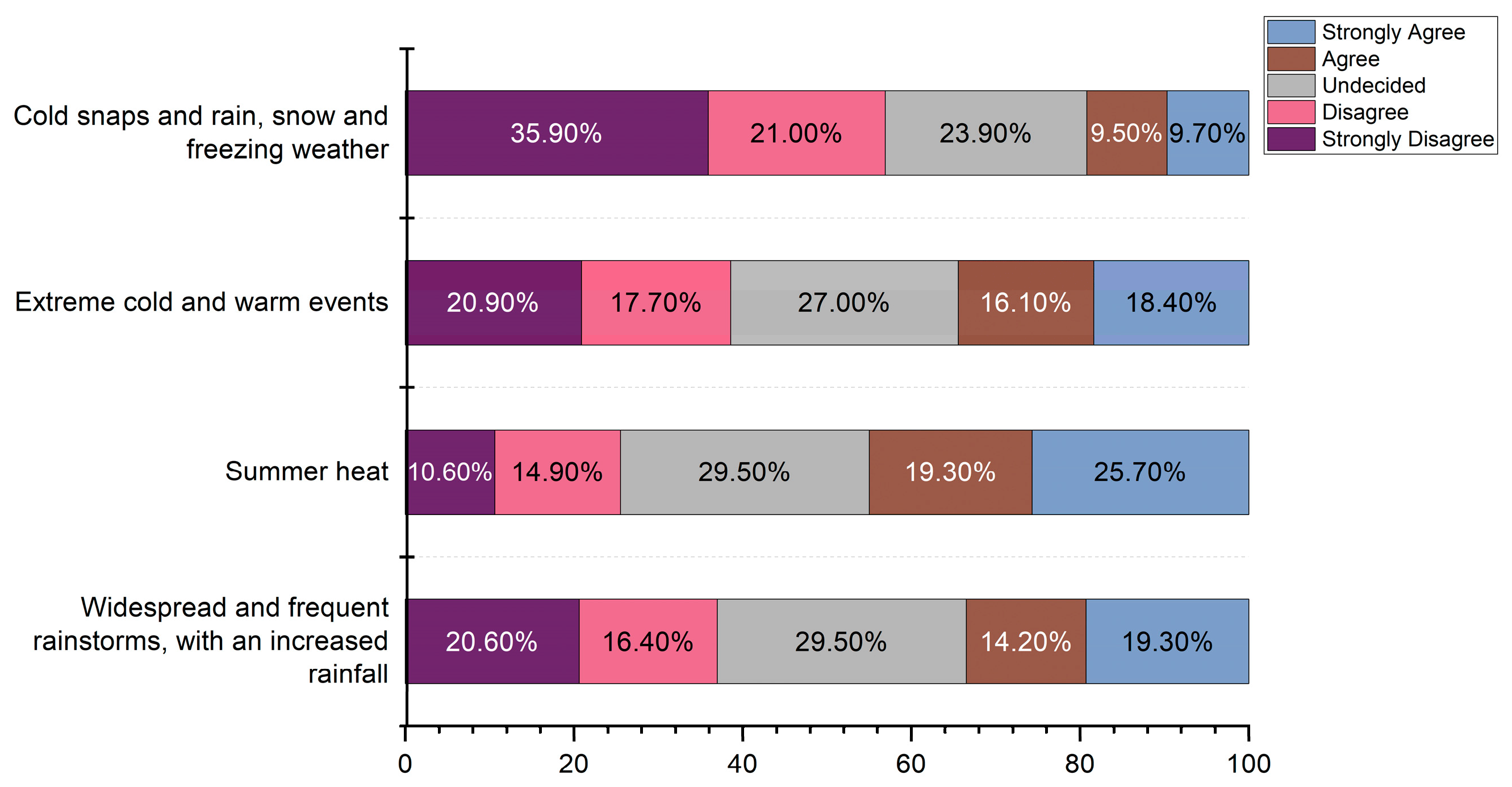
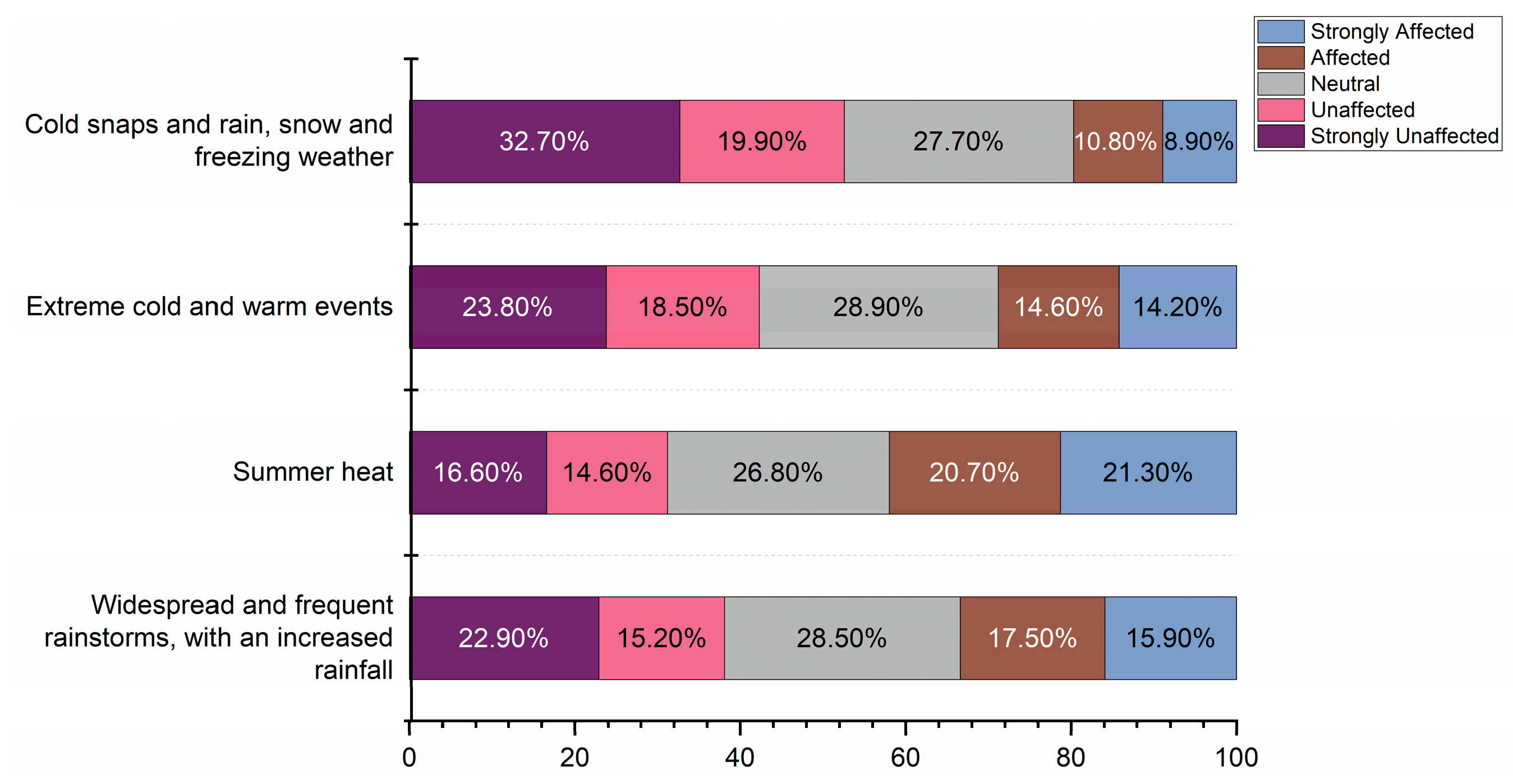
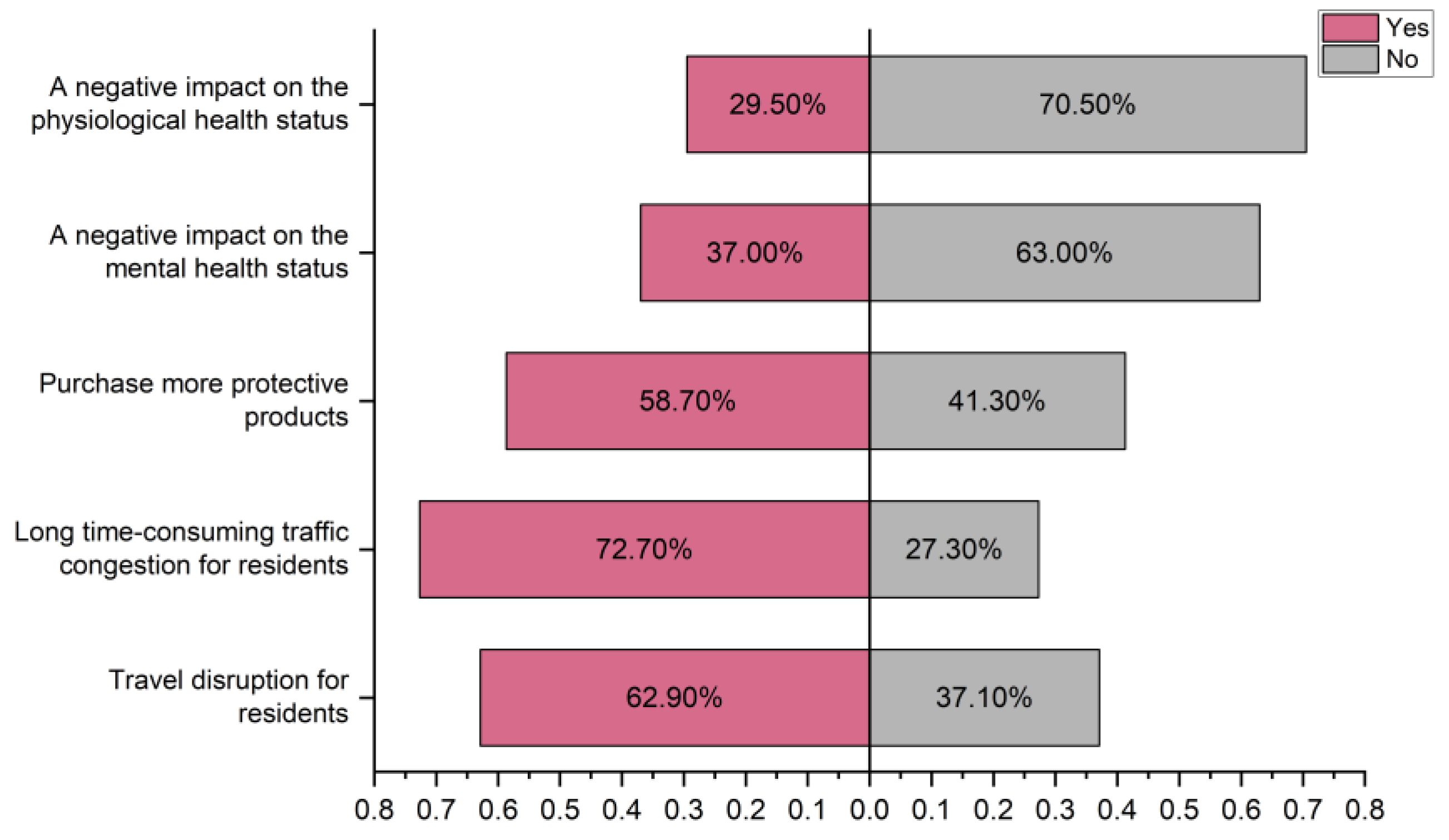
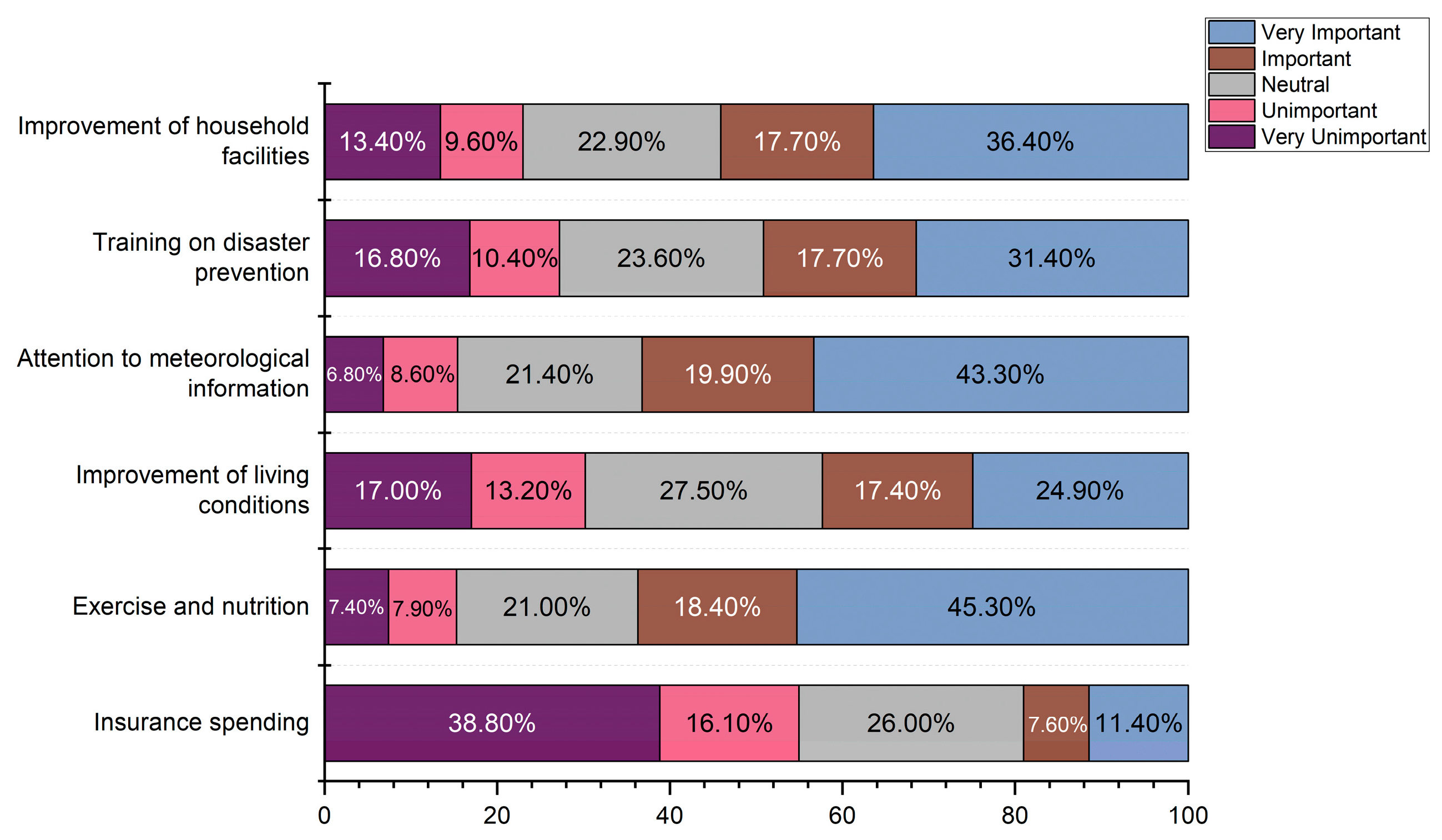
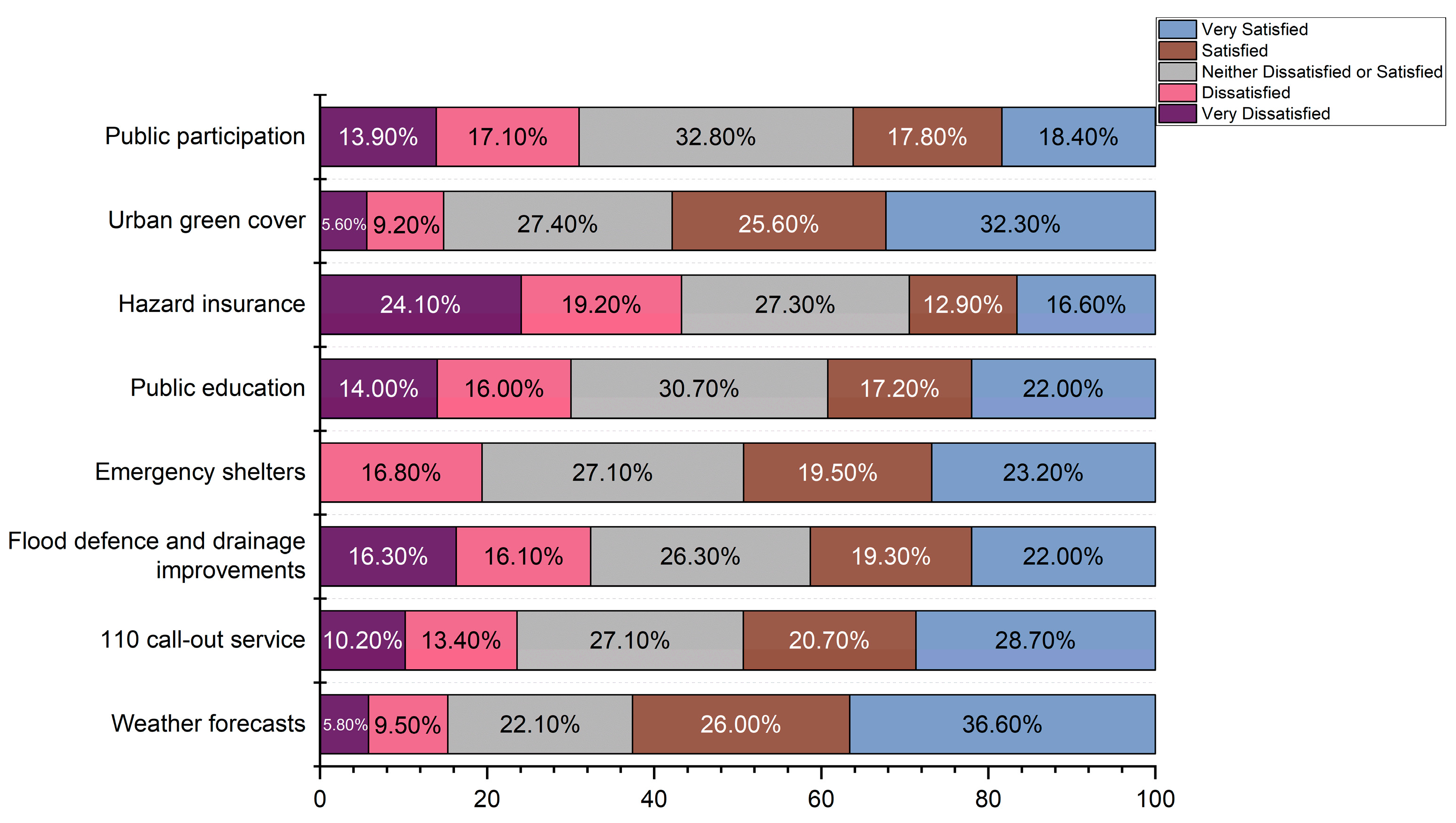
| Variable | Classifications | Quorum (Number) | Percentage (%) | Variable | Classification | Quorum (Number) | Percentage (%) |
|---|---|---|---|---|---|---|---|
| Gender | Man | 361 | 50.2 | Individual income | Less than CNY 3000 | 260 | 36.2 |
| Woman | 358 | 49.8 | CNY 3000–7000 | 301 | 41.9 | ||
| Age (years) | Under 18 | 49 | 6.8 | CNY 7000–20,000 | 136 | 18.9 | |
| 18–24 years | 109 | 15.2 | More than CNY 20,000 | 22 | 3.0 | ||
| 25–34 years | 193 | 26.8 | Academic qualifications | No Formal Education | 18 | 2.5 | |
| 35–44 years | 154 | 21.4 | Below Bachelor’s Degree | 292 | 40.6 | ||
| 45–54 years | 84 | 11.7 | Bachelor’s Degree | 362 | 50.3 | ||
| 55 years and over | 130 | 18.1 | Postgraduate Qualification | 47 | 6.5 |
| Implicit Variable | Observational Variables | Definition of Variables |
|---|---|---|
| ) | ) | 1 = Strongly Disagree; 2 = Disagree; 3 = Undecided; 4 = Agree; 5 = Strongly Agree |
| ) | 1 = Mainly due to Human Activities; 2 = Mainly Natural Variations; 3 = Unaware | |
| ) | ) | 1 = Strongly Unaffected; 2 = Unaffected; 3 = Neutral; 4 = Affected; 5 = Strongly Affected |
| ) | ||
| ) | 0 = No; 1 = Yes | |
| ) | ) | 1 = Can; 2 = Cannot; 3 = Unaware |
| ) | 0 = No; 1 = Yes | |
| ) | 1 = Very Unimportant; 2 = Unimportant; 3 = Neutral; 4 = Important; 5 = Very Important | |
| ) | 1 = Very Dissatisfied; 2 = Dissatisfied; 3 = Neither Dissatisfied or Satisfied; 4 = Satisfied; 5 = Very Satisfied | |
| ) | 1 = Very Unimportant; 2 = Unimportant; 3 = Neutral; 4 = Important; 5 = Very Important |
| Independent Variable | Definition of Variable (Number/Ratio) |
|---|---|
| ) | 0 = female; 1 = male |
| ) | Xi’an residency |
| ) | 1 = Under 18; 2 = 18–24; 3 = 25–34; 4 = 35–44; 5 = 45–54; 6 = 55 and over |
| ) | 1 = No Formal Education; 2 = Below Bachelor’s Degree; 3 = Bachelor’s Degree; 4 = Postgraduate Qualification |
| ) | 1 = less than 3000; 2 = 3000–7000; 3 = 7000–20,000; 4 = more than 20,000 |
| Independent Variable | Cold Snaps and Rain, Snow and Freezing Weather | |
|---|---|---|
| Regression Coefficient | OR | |
| Gender | ||
| Woman | −0.13 | 0.878 |
| Man | Referent | - |
| Length of residence | −0.003 | 0.997 |
| Age | ||
| Under 18 | −0.291 | 0.748 |
| 18–24 years | 0.827 *** | 2.286 |
| 25–34 years | 0.598 ** | 1.818 |
| 35–44 years | 0.804 *** | 2.234 |
| 45–54 years | 0.788 *** | 2.199 |
| 55 years and over | Referent | - |
| Academic qualifications | ||
| No formal education | 1.406 *** | 4.080 |
| Below bachelor’s degree | 0.286 | 1.331 |
| Bachelor’s degree | 0.259 | 1.296 |
| Postgraduate qualification | Referent | - |
| Incomes | ||
| Less than CNY 3000 | −0.046 | 0.955 |
| CNY 3000–7000 | 0.169 | 1.184 |
| CNY 7000–20,000 | 0.024 | 1.024 |
| More than CNY 20,000 | Referent | - |
| Independent Variable | Natural Causes vs. Anthropogenic Causes | Unaware vs. Anthropogenic Causes | ||
|---|---|---|---|---|
| Regression Coefficient | OR | Regression Coefficient | OR | |
| Gender | ||||
| Woman | −0.07 | 0.933 | 0.095 | 1.1 |
| Man | Referent | - | Referent | - |
| Length of residence | −0.005 | 0.995 | 0 | 1 |
| Age | ||||
| Under 18 | −1.23 *** | 0.292 | −1.422 ** | 0.241 |
| 18–24 years | −0.619 ** | 0.539 | −0.456 | 0.634 |
| 25–34 years | −0.417 | 0.659 | 0.177 | 1.193 |
| 35–44 years | −0.268 | 0.765 | 0.524 | 1.689 |
| 45–54 years | 0.262 | 1.299 | 0.746 | 2.108 |
| 55 years and over | Referent | - | Referent | - |
| Academic qualifications | ||||
| No formal education | 1.682 | 5.375 | 4.714 *** | 111.536 |
| Below bachelor’s degree | 0.129 | 1.137 | 2.347 ** | 10.457 |
| Bachelor’s degree | −0.506 | 0.603 | 1.16 | 3.191 |
| Postgraduate qualification | Referent | - | Referent | - |
| Income | ||||
| Less than CNY 3000 | −0.075 | 0.928 | 0.404 | 1.497 |
| CNY 3000–7000 | −0.097 | 0.907 | −0.42 | 0.657 |
| CNY 7000–20,000 | 0.058 | 1.06 | 0.083 | 1.087 |
| More than CNY 20,000 | Referent | - | Referent | - |
| Independent Variable | The Extent to Which Future Climate Risks Will Affect Daily Activities | |
|---|---|---|
| Regression Coefficient | OR | |
| Gender | ||
| Woman | −0.13 | 0.878 |
| Man | Referent | - |
| Length of residence | −0.003 | 0.997 |
| Age | ||
| Under 18 | −0.291 | 0.748 |
| 18–24 years | 0.827 *** | 2.286 |
| 25–34 years | 0.598 ** | 1.818 |
| 35–44 years | 0.804 *** | 2.234 |
| 45–54 years | 0.788 *** | 2.199 |
| 55 years and over | Referent | - |
| Academic qualifications | ||
| No formal education | 1.406 *** | 4.080 |
| Below bachelor’s degree | 0.286 | 1.331 |
| Bachelor’s degree | 0.259 | 1.296 |
| Postgraduate qualification | Referent | - |
| Income | ||
| Less than CNY 3000 | −0.046 | 0.955 |
| CNY 3000–7000 | 0.169 | 1.184 |
| CNY 7000–20,000 | 0.024 | 1.024 |
| More than CNY 20,000 | Referent | - |
| Independent Variable | Travel Disruption | Long Time-Consuming Traffic Congestion | Purchase More Protective Products | Mental Health Affected | Physical Health Affected | |||||
|---|---|---|---|---|---|---|---|---|---|---|
| Regression Coefficient | OR | Regression Coefficient | OR | Regression Coefficient | OR | Regression Coefficient | OR | Regression Coefficient | OR | |
| Gender | ||||||||||
| Woman | −0.31 * | 0.733 | −0.315 * | 0.73 | 0.316 * | 1.372 | −0.164 | 0.849 | −0.18 | 0.835 |
| Man | Referent | - | Referent | - | Referent | - | Referent | - | Referent | - |
| Length of residence | 0.006 | 1.007 | 0.005 | 1.005 | 0.009 * | 1.009 | 0.009 * | 1.009 | 0.007 | 1.007 |
| Age | ||||||||||
| Under 18 | 0.748 * | 2.114 | 1.318 *** | 3.736 | 0.473 | 1.605 | −0.484 | 0.617 | −0.544 | 0.58 |
| 18–24 years | 1.101 *** | 3.007 | 1.171 *** | 3.224 | 1.326 *** | 3.767 | 0.559 * | 1.749 | 0.254 | 1.289 |
| 25–34 years | 1.153 *** | 3.168 | 1.549 *** | 4.707 | 1.072 *** | 2.922 | 0.184 | 1.202 | 0.407 | 1.503 |
| 35–44 years | 1.114 *** | 3.047 | 1.195 *** | 3.302 | 0.827 *** | 2.287 | 0.321 | 1.378 | 0.245 | 1.278 |
| 45–54 years | 1.17 *** | 3.222 | 1.033 *** | 2.808 | 0.649 ** | 1.913 | 0.406 | 1.501 | 0.29 | 1.337 |
| 55 years and over | Referent | - | Referent | - | Referent | - | Referent | - | Referent | - |
| Academic qualifications | ||||||||||
| No formal education | 0.652 | 1.919 | −1.421 * | 0.242 | 0.992 * | 2.698 | 0.424 | 1.528 | 1.519 ** | 4.565 |
| Below bachelor’s degree | −0.311 | 0.733 | −1.755 *** | 0.173 | 0.89 ** | 2.435 | 0.397 | 1.487 | 0.841 * | 2.318 |
| Bachelor’s degree | −0.036 | 0.965 | −1.246 ** | 0.288 | 0.962 *** | 2.617 | 0.343 | 1.409 | 0.846 * | 2.33 |
| Postgraduate qualification | Referent | - | Referent | - | Referent | - | Referent | - | Referent | - |
| Incomes | ||||||||||
| Less than CNY 3000 | 0.438 | 1.55 | −0.123 | 0.884 | 0.441 | 1.554 | 0.27 | 1.31 | −0.065 | 0.937 |
| CNY 3000–7000 | 0.582 | 1.79 | 0.124 | 1.132 | 0.596 | 1.815 | 0.274 | 1.315 | −0.014 | 0.986 |
| CNY 7000–20,000 | 0.202 | 1.224 | −0.073 | 0.929 | 0.235 | 1.265 | −0.113 | 0.894 | −0.537 | 0.585 |
| More than CNY 20,000 | Referent | - | Referent | - | Referent | - | Referent | - | Referent | - |
| Constant | −0.646 | 0.524 | 1.473 * | 4.362 | −2.062 | 0.127 | −1.413 ** | 0.243 | −1.829 *** | 0.161 |
| Independent Variable | “Cannot” vs. “Can” | “Unaware” vs. “Can” | ||
|---|---|---|---|---|
| Regression Coefficient | OR | Regression Coefficient | OR | |
| Genders | ||||
| Woman | 0.126 | 1.134 | 0.674 *** | 1.962 |
| Man | Referent | - | Referent | - |
| Length of residence | −0.007 | 0.993 | 0.014 ** | 1.014 |
| Age | ||||
| Under 18 | 0.028 | 1.029 | 1.711 *** | 5.534 |
| 18–24 years | 0.129 | 1.138 | 1.187 *** | 3.277 |
| 25–34 years | 0.897 ** | 2.453 | 1.74 *** | 5.698 |
| 35–44 years | 0.76 ** | 2.139 | 1.041 *** | 2.831 |
| 45–54 years | 1.377 *** | 3.963 | 0.946 *** | 2.575 |
| 55 years and over | Referent | - | Referent | - |
| Academic qualifications | ||||
| No formal education | 0.26 | 1.296 | 0.178 | 1.195 |
| Below bachelor’s degree | 0.03 | 1.03 | −0.284 | 0.752 |
| Bachelor’s degree | 0.339 | 1.403 | 0.049 | 1.051 |
| Postgraduate qualification | Referent | - | Referent | - |
| Incomes | ||||
| Less than CNY 3000 | −0.226 | 0.797 | 0.477 | 1.611 |
| CNY 3000–7000 | −0.052 | 0.95 | 0.509 | 1.664 |
| CNY 7000–20,000 | −0.661 | 0.516 | 0.368 | 1.445 |
| More than CNY 20,000 | Referent | - | Referent | - |
| Independent Variable | Satisfaction with Weather Forecasts | Satisfaction with Flood Defense and Drainage Improvements | Satisfaction with Emergency Shelters | Satisfaction with Hazard Insurance | Perceived Importance of Weather Forecasts | |||||
|---|---|---|---|---|---|---|---|---|---|---|
| Regression Coefficient | OR | Regression Coefficient | OR | Regression Coefficient | OR | Regression Coefficient | OR | Regression Coefficient | OR | |
| Gender | ||||||||||
| Woman | 0.005 | 1.005 | 0.319 ** | 1.376 | 0.08 | 1.083 | 0.044 | 1.045 | 0.062 | 1.064 |
| Man | Referent | - | Referent | - | Referent | - | Referent | - | Referent | - |
| Length of residence | 0.008 * | 1.008 | −0.002 | 0.998 | −0.002 | 0.998 | −0.005 | 0.995 | −0.002 | 0.998 |
| Age | ||||||||||
| Under 18 | −0.435 | 0.647 | 0.158 | 1.171 | 0.118 | 1.125 | 1.154 *** | 3.171 | −1.134 *** | 0.322 |
| 18–24 years | −0.69 ** | 0.502 | 0.173 | 1.189 | 0.266 | 1.305 | 0.926 *** | 2.524 | −0.925 | 0.397 |
| 25–34 years | −0.631 ** | 0.532 | −0.025 | 0.975 | −0.082 | 0.921 | 0.644 *** | 1.904 | −0.877 | 0.416 |
| 35–44 years | −0.159 | 0.853 | 0.061 | 1.063 | −0.167 | 0.846 | 0.334 | 1.397 | −0.62 | 0.538 |
| 45–54 years | −0.648 ** | 0.523 | −0.453 * | 0.636 | −0.496 * | 0.609 | 0.037 | 1.038 | −0.568 | 0.567 |
| 55 years and over | Referent | - | Referent | - | Referent | - | Referent | - | Referent | - |
| Academic qualifications | ||||||||||
| No formal education | 0.147 | 1.158 | 0.712 | 2.038 | 1.003 * | 2.726 | 0.68 | 1.974 | −0.24 | 0.787 |
| Below bachelor’s degree | 0.061 | 1.063 | 0.579 * | 1.784 | 0.406 | 1.501 | 0.544 * | 1.723 | −0.295 | 0.745 |
| Bachelor’s degree | 0.148 | 1.160 | −0.13 | 0.878 | 0.133 | 1.142 | 0.329 | 1.390 | −0.07 | 0.932 |
| Postgraduate qualification | Referent | - | Referent | - | Referent | - | Referent | - | Referent | - |
| Income | ||||||||||
| Less than CNY 3000 | 0.593 | 1.809 | −0.605 | 0.546 | −0.328 | 0.720 | −0.285 | 0.752 | 0.921 * | 2.512 |
| CNY 3000–7000 | 0.285 | 1.330 | −0.739 * | 0.478 | −0.541 | 0.582 | −0.392 | 0.676 | 0.525 | 1.690 |
| CNY 7000–20,000 | 0.13 | 1.139 | −1.216 *** | 0.296 | −0.7 * | 0.497 | −0.627 | 0.534 | 0.38 | 1.462 |
| More than CNY 20,000 | Referent | - | Referent | - | Referent | - | Referent | - | Referent | - |
Disclaimer/Publisher’s Note: The statements, opinions and data contained in all publications are solely those of the individual author(s) and contributor(s) and not of MDPI and/or the editor(s). MDPI and/or the editor(s) disclaim responsibility for any injury to people or property resulting from any ideas, methods, instructions or products referred to in the content. |
© 2024 by the authors. Licensee MDPI, Basel, Switzerland. This article is an open access article distributed under the terms and conditions of the Creative Commons Attribution (CC BY) license (https://creativecommons.org/licenses/by/4.0/).
Share and Cite
Yang, R.; Liang, W.; Qin, P.; Anikejiang, B.; Ma, J.; Baratjan, S. Research on Cognition and Adaptation to Climate Risks among Inland Northwest Chinese Residents. Sustainability 2024, 16, 5775. https://doi.org/10.3390/su16135775
Yang R, Liang W, Qin P, Anikejiang B, Ma J, Baratjan S. Research on Cognition and Adaptation to Climate Risks among Inland Northwest Chinese Residents. Sustainability. 2024; 16(13):5775. https://doi.org/10.3390/su16135775
Chicago/Turabian StyleYang, Rui, Wei Liang, Peiyu Qin, Buerlan Anikejiang, Jingwen Ma, and Sabahat Baratjan. 2024. "Research on Cognition and Adaptation to Climate Risks among Inland Northwest Chinese Residents" Sustainability 16, no. 13: 5775. https://doi.org/10.3390/su16135775






